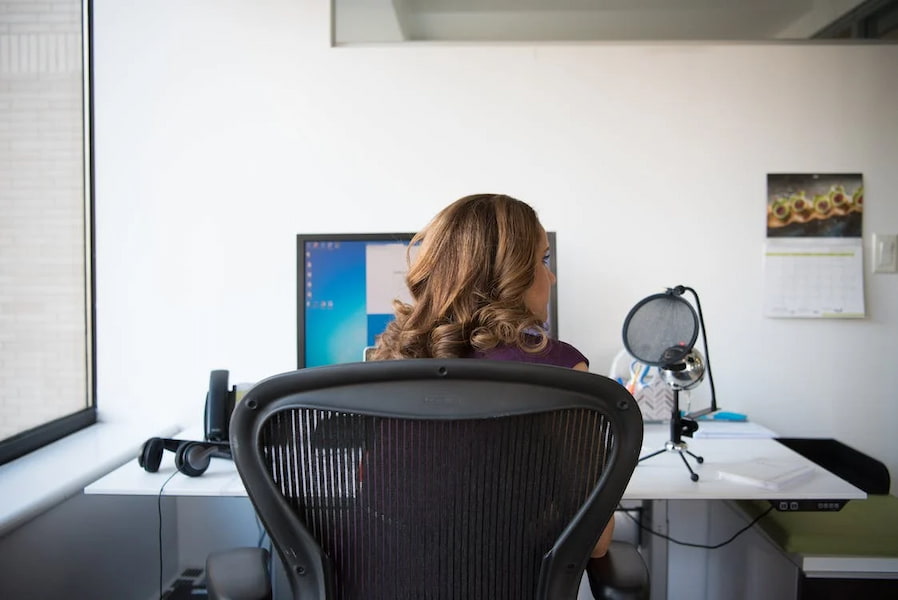The key to a comfortable workspace is avoid the common mistakes with regard to ergonomics. And by setting up your home office with comfort in mind, injury and pain are avoided.
Let’s find out what mistakes have we been making for some time, how to combat these pitfalls, and improve working conditions.

1. Hunching Over Your Laptop
Why is it a mistake?
Hunching over your laptop can cause neck and back pain, arm and shoulder pain, and eye strain. A group of researchers claimed this in their study about Office Ergonomics: Deficiencies in Computer Workstation Design which was published in the International Journal of Occupational Safety and Ergonomics.
What are the causes?
Using a computer for long periods, not having a proper workstation, using a laptop screen that is too low, and having poor posture habits can all cause hunching over your laptop.
What are the solutions?
Use an external monitor and keyboard, use a laptop stand, adjust your chair height, sit up straight, and take breaks to avoid hunching over your laptop.
Keep your spine in a neutral position, keep your shoulders relaxed, keep your elbows at a 90-degree angle, and keep your wrists straight. Talk to an ergonomist if you are struggling to maintain good posture.

2. Working on Incorrect Height
Why is it a mistake?
Working at an incorrect height can cause wrist pain and carpal tunnel syndrome.
What are the causes?
The causes of working at an incorrect height include using a desk or table that is too high or too low, and not using an adjustable chair.
What are the solutions?
To avoid working at an incorrect height, adjust your desk or table to a height so that your elbows naturally fall flush with the surface. An adjustable chair will need to be adjusted so that your feet are flat on the floor and your thighs are parallel to the floor. Without an adjustable chair, you may need to use a footrest.

3. Not Using the Office Chair
Why is it a mistake?
First, office chairs are designed to provide support for your back and neck, which can help to prevent pain and discomfort.
Second, office chairs often have adjustable features, such as seat height, backrest angle, and armrests, which allow you to customise the chair to fit your body and your specific needs.
When you sit in a chair that does not provide adequate support, you are more likely to hunch over, which can put strain on your back, neck, and shoulders. This can lead to pain, fatigue, and even serious injuries, such as herniated discs and carpal tunnel syndrome.
What are the causes?
Some people may simply not have an office chair at home. Others may find that their office chair is uncomfortable or does not fit their needs. Still, others may simply not be aware of the importance of using an ergonomic chair.
What are the solutions?
An office chair is a must-have for anyone who works on a computer for several hours. When choosing an office chair, look for one with adjustable features and good lumbar support.
In case your office chair is uncomfortable or does not fit your needs, consider making adjustments.
You can adjust the seat height, backrest angle, and armrests to find a position that is comfortable for you. Also, consider using a lumbar pillow to provide additional support for your lower back.
It is important to educate yourself about the benefits of using an ergonomic chair when working from home.
Ergonomic interventions can reduce musculoskeletal pain in desk workers, particularly in the neck, shoulder, upper back, and wrist/hand.
This has been concluded in a study conducted by a group of researchers in 2021 entitled Effect of an ergonomic intervention involving workstation adjustments on musculoskeletal pain in office workers – a randomised controlled clinical trial.

4. Dangling Your Feet
Why is it a mistake?
Dangling your feet can cause poor circulation, leg fatigue, and back pain. When you dangle your feet, your blood has to work harder to flow back to your heart.
This can lead to poor circulation, which can cause your feet to feel cold, numb, or tingling. Dangling your feet can also put strain on your back muscles, leading to back pain.
What are the causes?
The causes of dangling your feet include using a chair that is too high, not having a footrest, and poor posture habits.
What are the solutions?
To avoid dangling your feet, adjust your chair height so your feet can rest flat on the floor. Use a footrest (a box or a few books will also work) to support your feet.
You should also try to maintain good posture while sitting, with your back straight and your shoulders relaxed.

5. Not Practicing the 20/20/20 Rule
Why is it a mistake?
Not practising the 20/20/20 rule can cause eye strain, headaches, and blurred vision. When you focus on a close object, such as a computer screen, for long periods, your eye muscles can become fatigued. This can lead to eye strain, headaches, and blurred vision.
What are the causes?
The causes of not practising the 20/20/20 rule include being too focused on work, forgetting to take breaks, and not knowing about the 20/20/20 rule.
What are the solutions?
To avoid eye strain, headaches, and blurred vision, practice the 20/20/20 rule. This means that every 20 minutes of looking at a computer screen, you should take a 20-second break to look at something at least 20 feet away. You can set a timer to remind yourself to take breaks.

6. Turning Your Couch into a Workstation
Why is it a mistake?
Turning your couch into a workstation can cause back pain, neck pain, and wrist pain. Couches are not designed to be workstations, and they often do not provide adequate support for your body.
When you sit on a couch for a long time, you are more likely to hunch over, which can put strain on your back, neck, and wrists.
What are the causes?
The causes of turning your couch into a workstation include not having a proper desk or chair, wanting to be comfortable while working, and not knowing the ergonomic risks associated with working on a couch.
What are the solutions?
To avoid back pain, neck pain, and wrist pain, it is important to use a proper desk and chair when working. In case you have to work on a couch, try a laptop stand to raise your screen to eye level and a keyboard tray to raise your keyboard to a comfortable height. You should also take breaks every 20-30 minutes to get up and move around.

7. Not Customising Your Workstation Space Accordingly
Why is it a mistake?
Not customising your workspace accordingly can cause a variety of problems, such as pain and discomfort, decreased productivity, and increased risk of injuries.
When your workspace is not set up properly, you may be forced to work in awkward or uncomfortable positions, which can lead to muscle strain and fatigue. You may also have difficulty reaching certain items or tools, which can reduce your productivity.
Moreover, working in a poorly designed workspace can increase your risk of developing repetitive strain injuries (RSIs), such as carpal tunnel syndrome.
What are the causes?
Some people may not be aware of the importance of ergonomics, while others may simply not have the time or resources to make changes to their workspace.
What are the solutions?
When possible, customise your workspace to fit your individual needs. This may involve adjusting the height of your desk and chair, positioning your monitor at eye level, and using ergonomic peripherals, such as a keyboard and mouse.
You should also make sure that you have enough space to move around freely and that all of the items you need are within easy reach.
In situations where you cannot customise your workspace completely, you can still make some changes to improve your comfort and safety.
For example, with a desk that is too high or too low, you can use a keyboard tray or footrest to adjust its height. A monitor that is not at eye level can be adjusted with a monitor stand so you can raise it.

8. Skipping Meals and Getting Dehydrated
Why is it a mistake?
Skipping meals and getting dehydrated can cause some problems, including fatigue, headaches, and difficulty concentrating. When you don’t eat or drink enough, your body doesn’t have the fuel it needs to function properly.
This can lead to fatigue, headaches, and other symptoms that can make it a challenge to work effectively.
What are the causes?
Some people may be too busy to take breaks to eat and drink, while others may simply forget. Additionally, some people may not be aware of the importance of staying hydrated and eating regular meals.
What are the solutions?
To avoid skipping meals and getting dehydrated, try to make time for breaks throughout the day. Set a timer to remind yourself to take breaks, and use that time to eat and drink something. It is also important to choose healthy foods and drinks, such as fruits, vegetables, and water.

9. Incorrect Lighting
Why is it a mistake?
Incorrect lighting can cause eye strain, headaches, and fatigue. When the lighting is too dim, your eyes have to work harder to see, which can lead to eye strain and headaches.
When the lighting is too bright, it can cause glare and discomfort, which can also lead to eye strain and headaches.
What are the causes?
Some people may not have enough natural light in their workspace, while others may not have the right type of artificial lighting. Furthermore, some people may not be aware of the importance of proper lighting for ergonomics.
What are the solutions?
When possible, try to position your workspace near a window so that you can have access to natural light. In areas where there is little natural light, you can use artificial lighting to supplement it. Choose lamps that provide soft, diffused light. Avoid using overhead fluorescent lights, as they can be too harsh.
You can also adjust the brightness of your computer screen to reduce glare. You may want to consider using an external monitor, as laptop screens are often too bright.
How Do I Create an Ergonomic Home Office?
To create an ergonomic home office, you should consider the following factors:
Desk: A sit-stand desk is a great option for an ergonomic home office, as it allows you to alternate between sitting and standing throughout the day. This can help to reduce fatigue and improve your overall posture.
In the absence of a sit-stand desk, you can still create an ergonomic workspace by adjusting the height of your desk chair so that your elbows are bent at a 90-degree angle when your hands are resting on the keyboard.
Chair: An ergonomic chair is essential for preventing neck and lower back pain. Look for a chair with adjustable features, such as seat height, backrest angle, and armrests. This will allow you to customise the chair to fit your body and your specific needs.
Monitor: Your monitor should be positioned at eye level so that you do not have to tilt your head up or down to see it. You can use a monitor arm to raise or lower your monitor to the correct height.
Conclusion
Working from home can be a great way to balance your work and personal life, but it’s important to ensure your home office is set up ergonomically to avoid discomfort and injury. By avoiding the ergonomics mistakes discussed, you can create a home office that is comfortable and productive.
- 6 Benefits of Using Seat Cushion - February 20, 2024
- 4 Tips to Fix Uncomfortable Chair - February 19, 2024
- How to Position Lumbar Support on Ergonomic Chair - February 15, 2024

